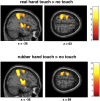Dispositional empathy predicts primary somatosensory cortex activity while receiving touch by a hand
- PMID: 34050215
- PMCID: PMC8163792
- DOI: 10.1038/s41598-021-90344-x
Dispositional empathy predicts primary somatosensory cortex activity while receiving touch by a hand
Abstract
Previous research revealed an active network of brain areas such as insula and anterior cingulate cortex when witnessing somebody else in pain and feeling empathy. But numerous studies also suggested a role of the somatosensory cortices for state and trait empathy. While recent studies highlight the role of the observer's primary somatosensory cortex when seeing painful or nonpainful touch, the interaction of somatosensory cortex activity with empathy when receiving touch on the own body is unknown. The current study examines the relationship of touch related somatosensory cortex activity with dispositional empathy by employing an fMRI approach. Participants were touched on the palm of the hand either by the hand of an experimenter or by a rubber hand. We found that the BOLD responses in the primary somatosensory cortex were associated with empathy personality traits personal distress and perspective taking. This relationship was observed when participants were touched both with the experimenter's real hand or a rubber hand. What is the reason for this link between touch perception and trait empathy? We argue that more empathic individuals may express stronger attention both to other's human perceptions as well as to the own sensations. In this way, higher dispositional empathy levels might enhance tactile processing by top-down processes. We discuss possible implications of these findings.
Conflict of interest statement
The authors declare no competing interests.
Figures



Similar articles
-
Embodied empathy for tactile events: Interindividual differences and vicarious somatosensory responses during touch observation.Neuroimage. 2012 Apr 2;60(2):952-7. doi: 10.1016/j.neuroimage.2012.01.112. Epub 2012 Jan 28. Neuroimage. 2012. PMID: 22306799
-
Effects of different viewing perspectives on somatosensory activations during observation of touch.Hum Brain Mapp. 2009 Sep;30(9):2722-30. doi: 10.1002/hbm.20701. Hum Brain Mapp. 2009. PMID: 19172650 Free PMC article.
-
Functional MRI Responses to Passive, Active, and Observed Touch in Somatosensory and Insular Cortices of the Macaque Monkey.J Neurosci. 2018 Apr 11;38(15):3689-3707. doi: 10.1523/JNEUROSCI.1587-17.2018. Epub 2018 Mar 14. J Neurosci. 2018. PMID: 29540550 Free PMC article.
-
Meta-analytic evidence for common and distinct neural networks associated with directly experienced pain and empathy for pain.Neuroimage. 2011 Feb 1;54(3):2492-502. doi: 10.1016/j.neuroimage.2010.10.014. Epub 2010 Oct 12. Neuroimage. 2011. PMID: 20946964 Review.
-
A meta-analysis of neuroimaging studies on pain empathy: investigating the role of visual information and observers' perspective.Soc Cogn Affect Neurosci. 2019 Aug 31;14(8):789-813. doi: 10.1093/scan/nsz055. Soc Cogn Affect Neurosci. 2019. PMID: 31393982 Free PMC article.
Cited by
-
Research Progress on Neural Processing of Hand and Forearm Tactile Sensation: A Review Based on fMRI Research.Neuropsychiatr Dis Treat. 2025 Jan 31;21:193-212. doi: 10.2147/NDT.S488059. eCollection 2025. Neuropsychiatr Dis Treat. 2025. PMID: 39906284 Free PMC article. Review.
-
Of Orchids and Dandelions: Empathy but Not Sensory Processing Sensitivity Is Associated with Tactile Discrimination Abilities.Brain Sci. 2022 May 12;12(5):641. doi: 10.3390/brainsci12050641. Brain Sci. 2022. PMID: 35625027 Free PMC article.
-
Mid-Air Tactile Sensations Evoked by Laser-Induced Plasma: A Neurophysiological Study.Front Neurosci. 2021 Oct 1;15:733423. doi: 10.3389/fnins.2021.733423. eCollection 2021. Front Neurosci. 2021. PMID: 34658771 Free PMC article.
References
-
- Hoffman ML. Emapthy and Moral Development: Implications for Caring and Justice. Cambridge University Press; 2007.
-
- Neumann DL, Chan RCK, Boyle GJ, Wang Y, Westbury HR. Measures of empathy. In: Boyle GJ, Saklofske DH, editors. Measures of personality and social psychological constructs. Elsevier; 2015. pp. 257–289.
Publication types
MeSH terms
LinkOut - more resources
Full Text Sources
Other Literature Sources

